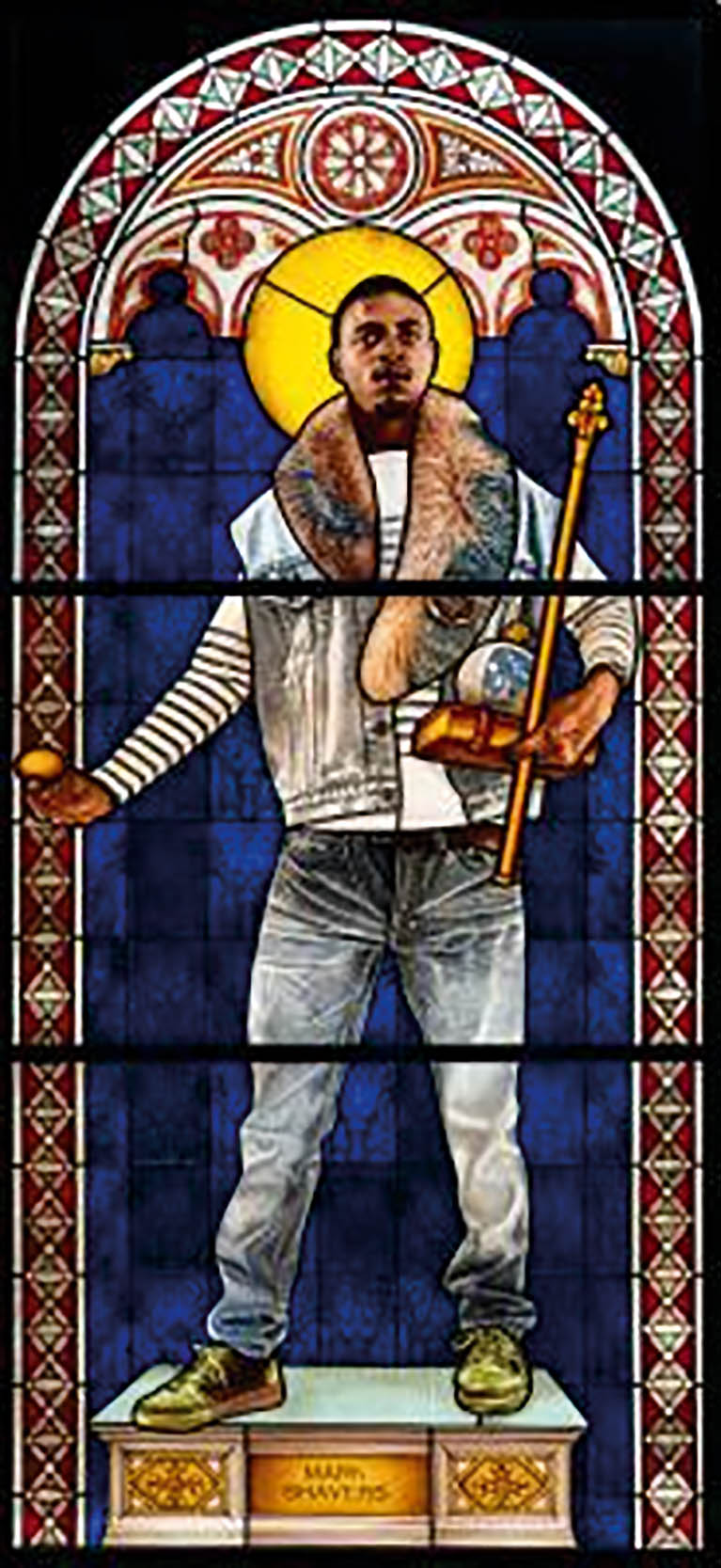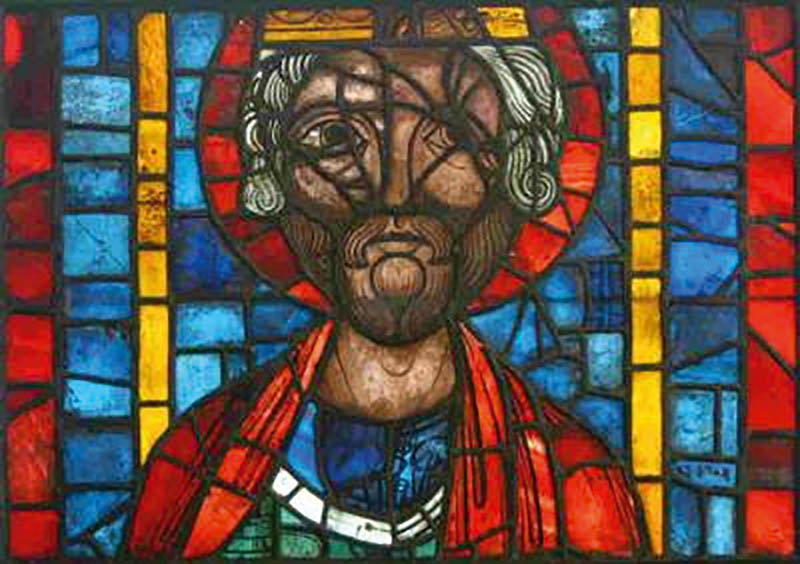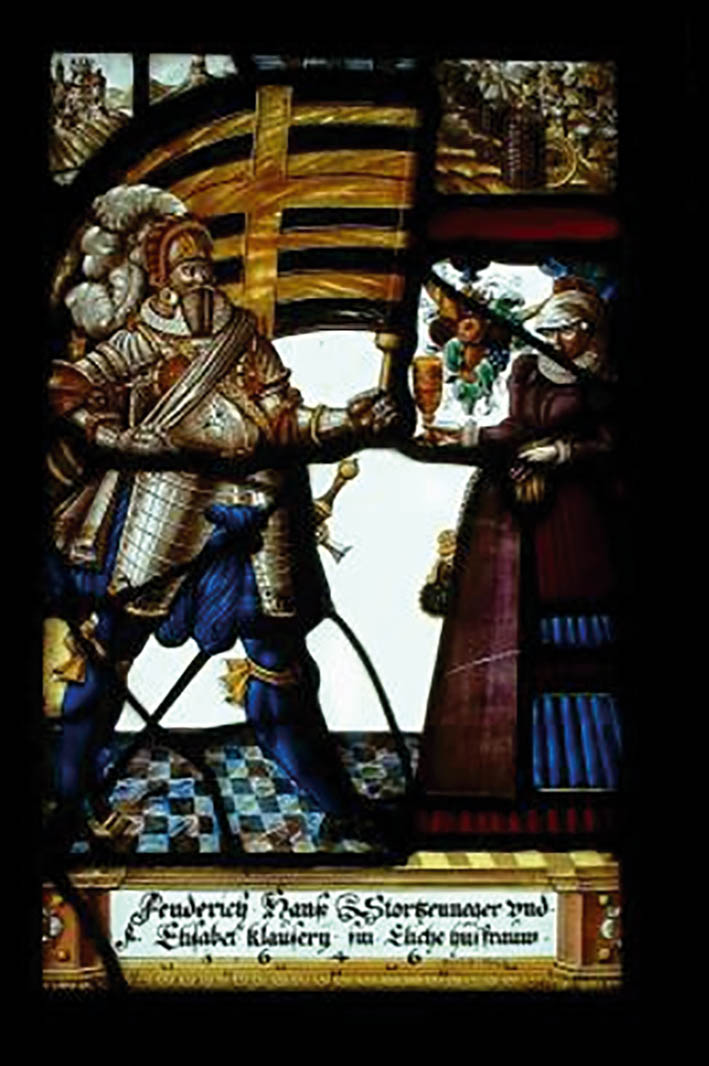Works of art: value beyond structure
 St Adelaide, 2014, inspired by a stained glass window after Jean Auguste Dominique Ingres. Designed by Kehinde Wiley, made by Skloart StudiosFine art consultant Patrick Bowen uses his experience in valuing stained glass to propose a new appreciation of its true value – both financially and artistically
St Adelaide, 2014, inspired by a stained glass window after Jean Auguste Dominique Ingres. Designed by Kehinde Wiley, made by Skloart StudiosFine art consultant Patrick Bowen uses his experience in valuing stained glass to propose a new appreciation of its true value – both financially and artistically
In a recent issue of Ecclesiastical and Heritage World (No 97) I drew attention to the possibility of a ‘grey area’ between a structural aspect of a building and a chattel which may be considered as movable property. It is an area of concern to all building surveyors and chattel surveyors.
Early this year I commenced a valuation on behalf of The Stained Glass Museum in Ely. It was a challenging undertaking, not least because of the sheer volume of items to be assessed and the nature of the items to be valued. The museum arguably holds the most extensive collection of ‘removed’ stained glass in the country and to be undertaking a valuation of such calibre was a great privilege.
The examples in the collection range from the earliest piece, which dates from the 13th century to contemporary, more recently commissioned pieces. Prior to this my experience with stained glass had been mainly with pieces in situ which I did not value and represented an aspect of a building rather than a stand-alone work of art: a notable exception being a country house with a church in the grounds and where the specific remit was to include the stained glass windows in the valuation.
There are, to my knowledge, a relatively small number of houses and institutional buildings, mainly Tudor and Stuart in origin, which have stained glass windows, whereas many examples are found in Victorian and Edwardian houses.
The majority of stained glass windows are to be found in church structures. However, over the centuries many of those buildings have been adversely affected by the rigours of conflict, particularly in the mid-17th century. The late 18th and early 19th centuries brought an era of neglect and subsequent deterioration of structures. Subsequently as a direct consequence of this a period of rescue or removal ensued.
 13th century, Bust of a King, from Soissons Cathedral, France, French artistChurch architecture experienced a revival in Victorian England during the Industrial Revolution, when places of worship were required for the vibrant communities which sprung up. Architects such as Augustus Pugin and Sir George Gilbert Scott became famous in subsequent years for creating numerous buildings, including churches which featured stained glass. Many parish churches and cathedrals were also restored in this period. The building of new churches brought with it numerous exponents of the art of stained glass. Edward Burne-Jones and the company Morris & Co represent good examples of the trend, but there were many others.
13th century, Bust of a King, from Soissons Cathedral, France, French artistChurch architecture experienced a revival in Victorian England during the Industrial Revolution, when places of worship were required for the vibrant communities which sprung up. Architects such as Augustus Pugin and Sir George Gilbert Scott became famous in subsequent years for creating numerous buildings, including churches which featured stained glass. Many parish churches and cathedrals were also restored in this period. The building of new churches brought with it numerous exponents of the art of stained glass. Edward Burne-Jones and the company Morris & Co represent good examples of the trend, but there were many others.
The trend decreased in the early 20th century and with it the need for stained glass design and construction. However, there have been exceptions, for example heavy bombing in Coventry during World War II saw the almost complete destruction of the city’s beautiful cathedral and the requirement for its extensive reconstruction. Within the new building there was a requirement for new stained glass.
The Metropolitan Cathedral of Christ the King was built in Liverpool in the 1960s and once again, stained glass was an integral element of the building. In the meantime, lesser parish churches were deconsecrated or demolished and much stained glass was removed. It became available on the open market with the items becoming more desirable in the fine art boom which occurred during the 1960s and 70s and continues to this day, albeit with different and ever-evolving emphasis.
 Attributed to Jakob Weber, 1646, commemorative panel depicting Frederick Hans Sturtzeneggar holding a standard, his wife offering a gobletThe Stained Glass Museum at Ely was established in the early 1970s. In its early incarnation the collection consisted mainly of donations, which became more wide ranging as interest in stained glass increased. The museum, which is currently located within Ely Cathedral, attracted many visitors and consequently funding increased. With that the curators of the museum have been able to add to the collection through the purchasing of examples of bespoke and ‘removed’ stained glass.
Attributed to Jakob Weber, 1646, commemorative panel depicting Frederick Hans Sturtzeneggar holding a standard, his wife offering a gobletThe Stained Glass Museum at Ely was established in the early 1970s. In its early incarnation the collection consisted mainly of donations, which became more wide ranging as interest in stained glass increased. The museum, which is currently located within Ely Cathedral, attracted many visitors and consequently funding increased. With that the curators of the museum have been able to add to the collection through the purchasing of examples of bespoke and ‘removed’ stained glass.
The collection has a depth to be anticipated in a museum of such calibre and it holds examples of stained glass which range through eight centuries. It is interesting to note that the most valuable pieces are the oldest and the most modern. The former is a 13th-century panel of Christ the King from a source in Soissons in France, while the latter is a large realist interpretation of an American Street character by Kelinde Wiley which was bought in 2021.
There are many other fine and interesting examples representing the centuries in between, including roundels of the seasons, a portrait of George III after Sir Joshua Reynolds, a collection of unusual portraits from 17th-century Europe and a plethora of examples of work from the great Gothic Revival period of the 19th century, including works by Morris & Co, Edward Burne-Jones and Dante Gabriel Rosetti. The more recent niche area representing stained glass as a trending art form holds fine examples by John Piper, Geoffrey Clark and, more recently still, Brian Clark. Even remnants of glass and designs on paper have their place in store. When presented with such a wealth of material I realised that quality stained glass pieces, and in particular examples associated with a world-famous artist or designer, have significant interest and value as stand-alone art works over and above and apart from inclusion in the structure of a particular building.
Despite this conclusion it remains important to note that works of stained glass are covered in most insurance policies for modern facsimile replacement in the event of damage or loss, unless particular pieces are specifically mentioned and valued. Examples of stained glass of the calibre exhibited at The Stained Glass Museum are rarely offered for sale on the open market, making it difficult to establish value in that sense. It is then left for the assessment of the calibre of the work itself: in particular if the work has been associated with a famous artist of a period and the condition of the panel being of paramount importance.
 Abstract panel, designed by John Piper and made by Patrick Reyntiens, circa 1956Another establishment for which I recently undertook valuation work has a fine stand-alone stained glass panel designed by John Piper on display, but inspection revealed a crack in the glass. The curator was dismayed to discover how much it would have been worth had the glass not been damaged in storage. At the same time I was informed that one of the Piper windows at Coventry Cathedral had been spoiled during a burglary in 2020, representing a substantial loss both financially and to the building. It is unlikely that the usual insurance cover in place would cover the expertise necessary to replace the glass to its original calibre or the actual loss.
Abstract panel, designed by John Piper and made by Patrick Reyntiens, circa 1956Another establishment for which I recently undertook valuation work has a fine stand-alone stained glass panel designed by John Piper on display, but inspection revealed a crack in the glass. The curator was dismayed to discover how much it would have been worth had the glass not been damaged in storage. At the same time I was informed that one of the Piper windows at Coventry Cathedral had been spoiled during a burglary in 2020, representing a substantial loss both financially and to the building. It is unlikely that the usual insurance cover in place would cover the expertise necessary to replace the glass to its original calibre or the actual loss.
These examples, taken from my own endeavours, may serve to highlight a new-found vulnerability in the area of stained glass and its role as a stand-alone work of art once removed from a building structure. It also draws attention to the need for proper consideration regarding storage and removal for display purposes. The nature of glass makes it very easy to damage and challenging to repair – significantly reducing its desirability and its value in the current marketplace. These considerations represent potentially heavy losses not only financially but also to the world of art.
In the current uncertainty surrounding the world’s economic structure and its impact on the everyday lives of people, stained glass may also become increasingly vulnerable to theft, as it does not need to remain a part of the structure but can easily become, with removal from the structure, a stand-alone and potentially valuable artefact.
For further information visit www.patrick-bowen.co.uk
• All images courtesy of The Stained Glass Museum, Ely.













